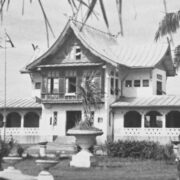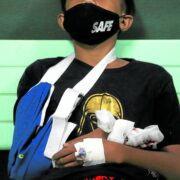Murder in San Agustin

This is my first column for the Inquirer under Inquirer Interactive. Nothing has changed except the sister company that succeeded the parent company. I guess many of the concerned readers who asked about my future and that of my column were nostalgic about the print edition that will still be available alongside the digital version. Both in the Inquirer and my own research, I have moved on long ago. I prefer digital copies to rare books and archival manuscripts because I am allergic to book dust. Four decades ago, when I started writing history, Filipino historians had to travel abroad to consult primary sources unavailable at home. Today, there is enough online to keep us occupied for many lifetimes.
For example, the only surviving copy of the “Doctrina Cristiana,” published in Manila in 1593, is preserved in the United States Library of Congress. Many researchers in the last century could only dream about consulting the original as I have, but today, you can browse the Doctrina remotely—online. A high-resolution copy is downloadable for free. In my opinion, the soft copy is far better for research and enjoyment than carefully handling the original. You can even zoom in on details, play with resolution and brightness, to reveal things others have not noticed before.
Armed with antihistamines, I sometimes dip into physical books. One that caught my eye in San Agustin was signed by Fray Vicente de Sepulveda, who was murdered in 1617 by fellow friars. His story is a footnote in history that reads like fiction.
In 1617, Intramuros was beset by a terrifying omen. A white cat was found in San Agustin suckling three rats. How these natural enemies became strange bedfellows was the talk of the town, more so when the cat devoured the rats a few days later. She nourished and fattened the rats with her milk! Naturally, people read into the event after the unexpected deaths of Diego Vazquez de Mercado, archbishop of Manila, and Jeronimo Salas, freshly minted Augustinian provincial. Misfortune was said to come in threes, so the city braced for another death foretold.
Salas died suddenly on May 17, 1617, just 20 days after his election as superior. Foul play was suspected but only confirmed after the death of his successor Sepulveda. A source described Sepulveda as: “thoroughly inflexible in character, he undertook to secure the most rigorous observance … a second time provincial … he did not change … his harsh and rigid mode of government. A lamentable and unexpected event put an end to his already harassed life on Aug. 1, 1617.”
Some members of the community decided to rid themselves of this strict superior with poison. That did not work, so they mixed ground glass with chocolate, his food, and even the wine he consecrated and consumed at mass!. Of small stature, Sepulveda looked like he would live to assume a third term after surviving eruptions on his body. Later, careful of his food and drink, he locked his cell securely at night. The mastermind of the murder was Juan de Ocadiz, who was ordered out of San Agustin and sent to Cavite to be shipped back to Spain and removed from the order. Desperate, Ocadiz took matters into his own hands assisted by Juan de Quintana, Andres Encinas, and Ignacio de Alcaras.
Before midnight on July 31, 1617, the group entered the superior’s cell using a copy of his keys. A light sleeper, Sepulveda shouted and stopped the young three accomplices in their tracks. They tried to back out, but Ocadiz threatened to stab them. After some hesitation, all four pounced on Sepulveda, threw him on the bed, covered his mouth, and then Ocadiz put his knees on Sepulveda’s stomach and began to strangle him. But then Sepulveda requested confession before death. Ocadiz replied, “Father, repent of your sins and in token of this, clasp my hand.” As Sepulveda did just that, Ocadiz declared, “Trust, Father in our Lord who will pardon your sins.” After absolution, Sepulveda was choked to death. His head twisted till the neck broke to resemble that of slaughtered fowl.
Sepulveda’s corpse was cleaned, bed sheets were changed, and everything arranged to appear like Sepulveda died in his sleep. The cell was bolted from the inside, and the murderers exited from a window. When the community assembled for matins on Aug. 1, 1617, Sepulveda was absent. The prior checked on Sepulveda, knocked at his door, and getting no response, had the door forced open, and the body was found. When the community came to pay their last respects, they noticed that Sepulveda’s index finger was raised, but only the guilty felt alluded to. Observing the demeanor of each monk who came to kiss the superior’s hand, the four killers were exposed. One escaped, while the remaining three were executed in front of the church, perhaps in the present parking lot where the Unesco marker now stands.
The irony is that the victim and his murderers were buried in the same grave to await the resurrection of the dead and the life of the world to come. When Fr. Policarpio Hernandez found me in the church one day in search of Sepulveda’s grave, he remarked with a smile: “Que mentiras vas a escriber esta vez? (What lies will you write about this time?)” A random signature on an old book reminded me of this 17th-century crime.
Ambeth is a Public Historian whose research covers 19th century Philippines: its art, culture, and the people who figure in the birth of the nation. Professor and former Chair, Department of History, Ateneo de Manila University, he writes a widely-read editorial page column for the Philippine Daily Inquirer, and has published over 30 books—the most recent being: Martial Law: Looking Back 15 (Anvil, 2021) and Yaman: History and Heritage in Philippine Money (Bangko Sentral ng Pilipinas, 2021).


















PH defense rise and Japan’s strategic shift